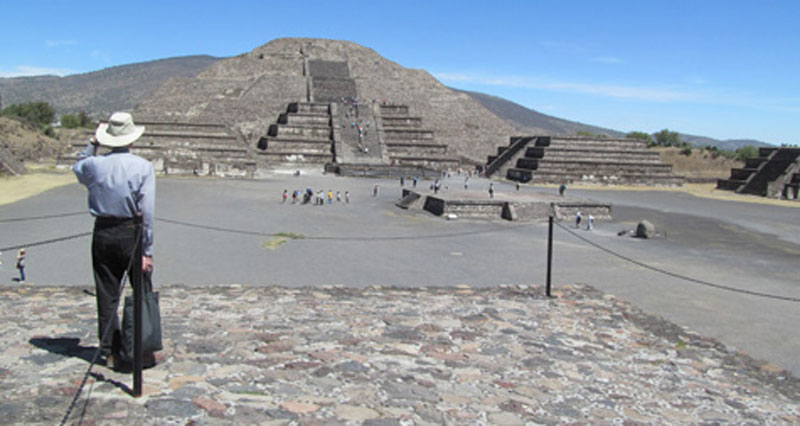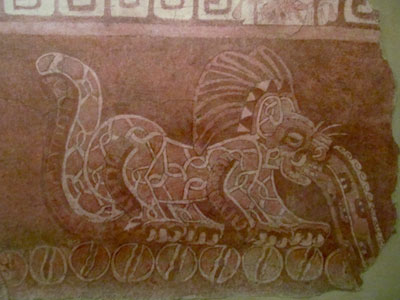Essential Teotihuacán
This item appears on page 53 of the September 2015 issue.
Teotihuacán is one of the world’s greatest archaeological sites. Located 30 miles northeast of Mexico City and now reachable via toll highway 85D or free highway 132D, it once was one of the most important hubs of the Mesoamerican world.
Its name means “Place of the Gods,” a name given to the city, after it was long abandoned, by the Nahua people, who settled there after AD 900. What the city’s original inhabitants called it — or even who they were or where they came from — is unknown, although one theory is that they migrated there from other parts of the central basin of Mexico.
After 150 BC, these first settlers built a city that grew to include the monumental structures visitors see today and whose population may have reached 150,000 to 200,000 in the years between AD 350 and 550.
Teotihuacán’s influence was far flung, as it traded with other regions of Mesoamerica as far east as present-day Guatemala, Belize and Honduras and with groups in northern and western Mexico.
After about AD 600 it began to decline, and by the mid-eighth century it was mostly abandoned. Whether it was internal warfare, external invasion or famine caused by drought that brought about the city’s demise is not known, but it was in ruins when the Nahua peoples arrived.
My husband, Paul, and I have visited Teotihuacán on every one of our many trips to Mexico City over the years. On these visits, we’ve explored every nook and cranny, or so it seemed to us at the time. It was what Paul called the “thorough Baedeker approach.”
On our most recent trip, in February 2015, we decided to “savor” Teotihuacán slowly and not try to see everything. We called this visit our “essential” Teotihuacán, paring it down to what we considered “best” and taking the time to slowly stroll among the monuments as well as to sit and admire the splendor of what surrounded us… while groups trooped by as if on forced marches.
The Citadel
We hired a private car and asked our driver to drop us off in Teotihuacán’s parking lot number one, which occupies what was once the ancient city’s market. From there, it was a short walk to the Citadel.
When the Spaniards first arrived in Teotihuacán, early in the 16th century, they named this complex the Citadel because it reminded them of a fortress. Its immense courtyard, 1,312 feet (400 meters) on each side, is enclosed by high platforms forming a continuous wall. Within the courtyard is a pyramid that seemed to the Spaniards like a castle within a defensive fortress.
The “castle” is actually the Temple of Quetzalcoatl, decorated with feathered serpents and goggle-eyed crocodiles. A later pyramid erected in front was meant to cover up the earlier pyramid.
The courtyard in front of these two pyramids could hold 100,000 spectators, who would come to witness the ceremonies performed there. The platforms enclosing the quadrangle once had temples on top, 15 of them.
Avenue of the Dead
From the Citadel, there’s a panoramic view of the Avenue of the Dead. This avenue was named by the Nahua peoples who arrived after the city had been deserted. They thought that the platforms and pyramids lining both sides of the avenue were burial mounds. Actually, they were pyramids with temples on top. Governing officials once might have lived in the complexes behind the pyramids.
From the Citadel to the Pyramid of the Moon at the end of the Avenue of the Dead it’s a 1.2-mile walk, made more difficult because of the stepped sunken patios along the route. We asked our driver to drop us off at parking lot number two and to wait for us at parking lot number three.
Pyramid of the Sun
The pyramids of the Sun and the Moon dominate the landscape of Teotihuacán.
At roughly midway between the Citadel and the Pyramid of the Moon, the Pyramid of the Sun is the first one we visited. This pyramid rises in five tiers to a height of 213 feet. Its base is enormous — 738 feet on each side — with a smaller pyramid attached to the western side and with a monumental staircase.
Visitors can climb the steep steps to the top. We’ve done it on past trips but didn’t this time, preferring the view — and the shade — at the pyramid’s bottom. We sat on the bottom steps imagining visitors 1,500 years ago approaching, awed at the pyramid’s grandeur and size.
Pyramid of the Moon
At the end of the Avenue of the Dead lies a large plaza surrounded by temples and palaces and with an altar in the middle. Behind this rises the Pyramid of the Moon. At 140 feet tall and with a base of 460 feet by 492 feet, it’s smaller than the Pyramid of the Sun but doesn’t seem so when you’re standing at its base.
The pyramid rises in four tiers, with a last “tier” of rubble on top. On its summit there was once a temple dedicated to Chalchiuhtlicue, the goddess of water, who is associated with the moon. Her statue, now in the National Museum of Anthropology in Mexico City, was found there.
To stand at the base of this pyramid or on top of the smaller, 5-tier pyramid at its foot and look down the Avenue of the Dead is one of the great experiences of a trip to Teotihuacán.
If you have the energy and the time, there are a number of palaces, temples and apartment complexes to explore scattered around the archaeological site close to the road encircling the zone.
Mural museum
We discovered Teotihuacán’s Museo de Murales Teotihuacanos on this trip. Located a 15-minute walk or a 5-minute drive from parking lot number three, it houses a fabulous collection of murals moved there from some of the on-site palaces.
One writer compared these murals to those of Pompeii. The comparison is apt. This museum is one of Teotihuacán’s “essentials.”
If you go…
Teotihuacán is open daily from 9 a.m. to 5 p.m., but check before going (www.teotihuacan.inah.gob.mx [in Spanish only]). The admission price is 64 pesos (about $4.25)
We did not want to be limited by the constraints of traveling with a group, so we hired a car and driver for the day. The cost was $200, including tip, for seven hours. Arrangements were made by the owner of the apartment where we stayed for 10 days.
We stayed at Bolivar Suites (phone 52 55 55 21 87 28, email petra.h.fischer@gmail.com or visit www.vrbo.com/38233), located on Calle Bolivar in the historic center of Mexico City and within walking distance of, or a short taxi ride from, much of what we wanted to see in Mexico City.
The penthouse apartment, with security on duty during the day, had a huge living/dining room with arcaded windows overlooking a plant-filled terrace and with a view of Palacio de Bellas Artes and the Torre (Tower) Latinoamericana.
There was a large kitchen with a washing machine plus four bedrooms and 3½ bathrooms. Prices were determined by the number of bedrooms wanted. The rate for one bedroom with a bath and a half was $220 per night, or $1,300 for a week.
The owner, Petra Fischer, offered an extensive “menu” of activities, ranging from classes in Mexican cooking to guided or unguided trips to sights in and around Mexico City, including Teotihuacán, the National Museum of Anthropology, sites associated with Diego Rivera and Frida Kahlo and the colonial cities of Taxco and Cuernavaca.


